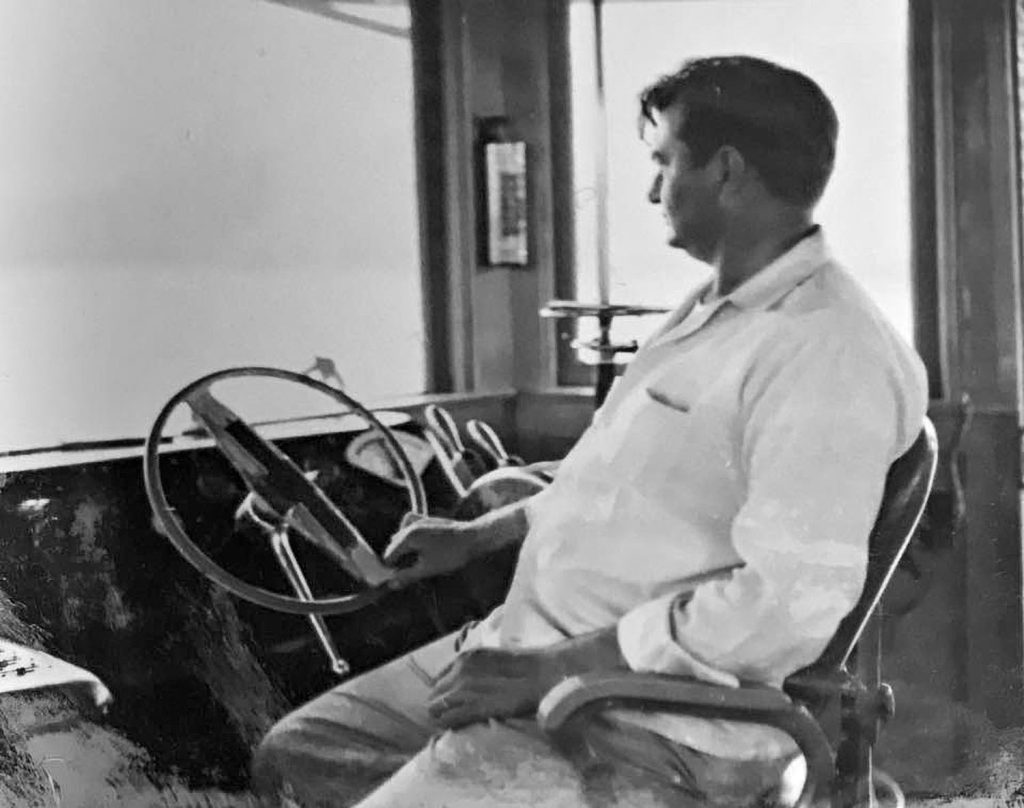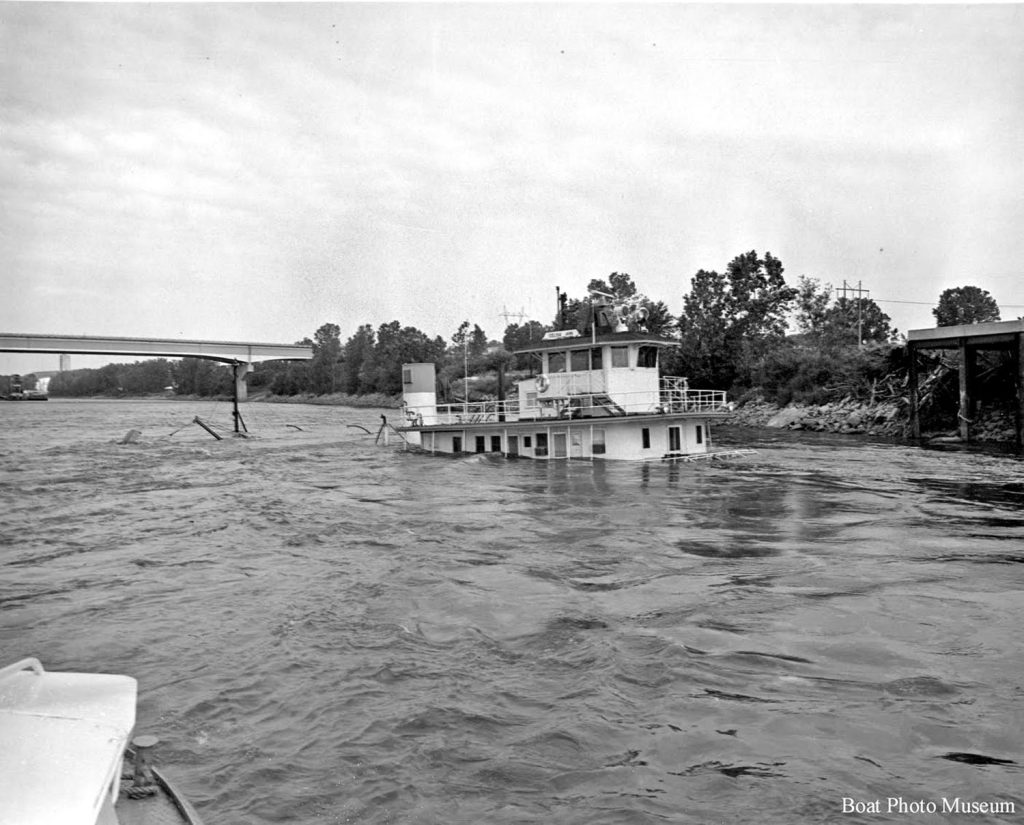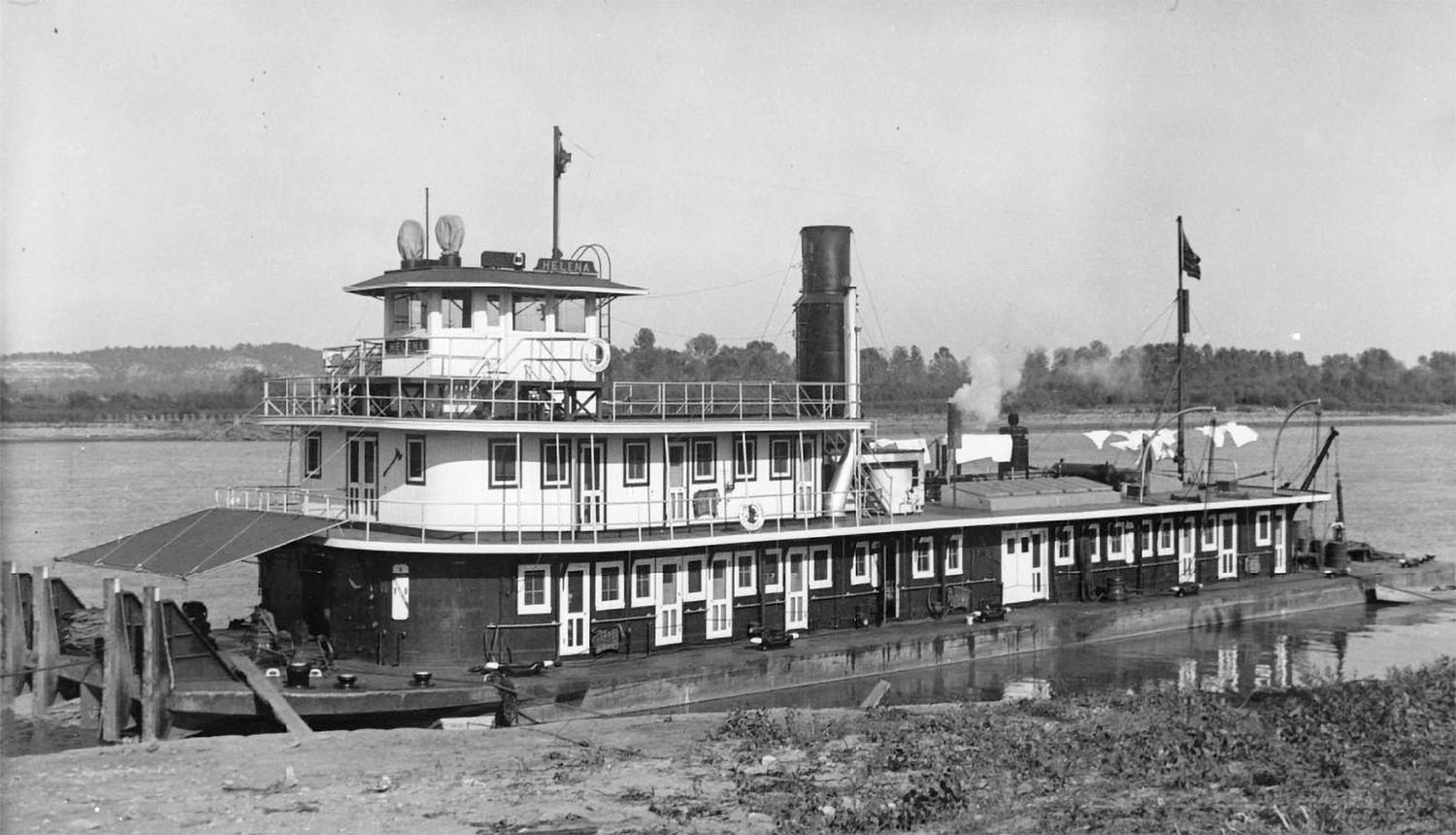In 1933, the Inland Waterways Corporation (IWC) had two diesel-powered twin-screw towboats built by Midland Barge Company, Midland, Pa. These were the Franklin D. Roosevelt and Tom Sawyer. In 1938-39, the IWC had three boats built of identical hull size and cabin design. One would be built by the Midland firm, one by Marietta Manufacturing Company at Point Pleasant, W.Va., and the last one, entering service in 1939, was built by Canulette Shipbuilding Company, Slidell, La.
While the Roosevelt and Tom Sawyer were built with diesel power, these three new boats, as well as the hawser tug Mobile (WJ February 6, 2023) that was built in the same time frame by Dubuque Boat & Boiler Company, were powered by steam. On the surface, this is surprising, since the IWC had been embracing diesel technology in a big way, not only with the Roosevelt and Tom Sawyer, which were each 1,000 hp., but also with the Herbert Hoover, then the largest (at 215 by 43 feet) and most powerful towboat on the rivers at a whopping 2,200 hp. The answer as to why was simple economics.
The IWC had been formed by the U.S. government in 1919 in an effort to revitalize river transportation. It was painfully obvious during the First World War that this form of transportation was vital yet had largely succumbed to the effects of rail and trucking. In 1920, four self-propelled barges were built at St. Louis for the IWC. These were twin-screw and steam-powered, intended for use on the Warrior-Tombigbee River system, but would often be in express service between New Orleans and St. Louis. These barges were named Birmingham, Gulfport, Mobile and Tuscaloosa. These craft had served their usefulness to the IWC and were being dismantled as the new boats were under construction. In order to save some money, the steam machinery from the barges was placed in the three new towboats and one tug.
The boat constructed at Midland was named Helena, after Helena, Ark. It had a steel hull that was 148 by 40 feet, and while the main cabin was also of steel construction, the upper cabin and pilothouse were crafted out of wood. The repurposed engines had been built by Nordberg and were triple-expansion, condensing with cylinders 10-1/4’s, 17’s, 28’s with 18-inch stroke rated 1,000 hp. at 225 rpm. The water tube boilers were oil-fired, and the props were 77 inches in diameter. Mrs. Thomas Q. Ashburn, wife of Maj. Gen. Ashburn, head of the IWC, christened the boat at Midland.
With the annual Missouri Navigators Meeting scheduled to be held this week on February 22 at Jefferson City, Mo., it is interesting to note that the new Helena ran on the Missouri River in 1939. Way’s Steam Towboat Directory says that its master in this trade was Capt. William Dudley “Curley” Young, a veteran of the challenging Missouri River back to the days of the A.M. Scott (WJ April 10, 2023). The Nordberg Manufacturing Company ran ads in The Waterways Journal in 1938 and 1939 featuring a photo of the Helena new at Midland and touting the fact that their engines, after nearly 20 years of service, had been deemed as good as new and placed in the Helena and sister vessels Kansas City and Huck Finn, as well as the tug Mobile.
The Helena was converted to diesel in 1947 with the steam engines being replaced by a pair of GM diesels rated 1,800 hp. at 900 rpm. Falk 2.6:1 reduction gears and kort nozzles were also placed during this rebuilding program that the Inland River Record notes as having taken place at St. Louis Ship (after the early 1950s the IRR no longer mentions the kort nozzles, so they may have been removed). The single smokestack remained in place, with the upper narrow portion removed. In 1952, it was repowered with EMD 12-567 engines, still rated 1,800 hp. In 1953, it was sold to Federal Barge Lines Inc., St. Louis. In 1961 it was sold to Wood River Towing Company, Wood River, Ill., and renamed Dan C.

Bill Burnett, of Boonville, Mo., is a grandson of Capt. A.C. Burnett, a principal in Wood River Towing, and Bill’s father was Capt. Dan C. Burnett, whom the Dan C was named after. Bill literally grew up around the boat and has very vivid memories of it. Capt. A.C. Burnett had spent many years with the IWC and Federal Barge Line and knew the boat well. Bill remembers that it still had a donkey boiler on board to run steam auxiliaries and that it had a huge WebbperfectioN oil burning range in the galley. These ranges were manufactured by Elisha Webb & Son Company, Philadelphia, Pa., and they advertised extensively in the WJ.
One very notable feature on the Dan C that may be interesting to those reading about modern wheelhouses was an automobile steering wheel that was mounted on the pilothouse console in lieu of traditional steering levers. A lever under this wheel operated the flanking rudders. This arrangement may have been placed when the boat was converted to diesel in 1947.
In September 1971, the boat was sold to Consolidated Towing Company, Excelsior Springs, Mo. In 1974, it was renamed Celisa Ann and repowered with EMD 12-645-E2 diesels generating 2,800 hp.

In 1976, the Celisa Ann was tied off on the Missouri River near Kansas City when it was broken loose from its moorings and then sank near Mile 360. The boat was raised, but Bill Burnett says that the upper wooden works had been destroyed, and it was a total loss.
Caption for top photo: Str. Helena when new. (Dan Owen Boat Photo Museum collection)
Capt. David Smith can be contacted at davidsmith1955obc@gmail.com.



